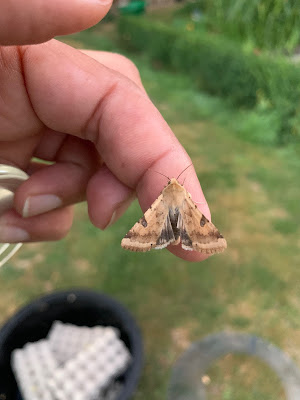Saturday, 31 December 2022
New Year's Eve trio
Wednesday, 21 December 2022
Stowe moths 2022
At the end of 2022, my third year of moth recording, the
garden total now stands at 517. The total for the year was 436, of which 102
were new, (38 macro, 64 micro). Light trapping was done on 174 nights with a
20W actinic and a 120W MV—some nights with both, but on a number of nights just
the MV, whilst the actinic was deployed off-site in local woodland. Best night
was 17 July with 350 moths of 100 species across the two traps.
Lunar Underwing returned to being the most numerous species, having
dropped to #6 in the ranking last year. Square-spot Rustic has
rapidly climbed the ranks from 12th place in 2020, to 7th
last year, to second most numerous in 2022. Most numerous micro was Chrysoteuchia
culmella as it has been every year.
Highlights included: Evergestis limbata, a first for Bucks,
and based on iRecord data this seems to be the furthest NW UK sighting, apart
from a couple of sites in Leicestershire, one of which seems to have recorded
the species almost annually for the past five years.
Clifden Nonpareil, (finally!); Dusky-lemon Sallow, with only one prior (1963) record in the whole of northwest Bucks up to the end of 2020; and three new clearwing species—Sallow Clearwing, Currant Clearwing and Hornet Moth, (with exit holes of the latter found in the base of a mature poplar), bringing the garden clearwing total to eight species.
As to migrants, several Rusty-dot Pearls and Vestals put in an appearance, both new to the garden, with the latter apparently being the first records for the hectad according to the Atlas. It was also good to add some more identified cnephasia and coleophora species to the list, thanks to Peter, as well as a few expected species that had not so far put in an appearance, such as Twenty-plume Moth, Blossom Underwing, Peach Blossom, Bright-line Brown-eye, and Ear Moth. Still plenty to go at though!
Monday, 19 December 2022
A moth!
Even though it became very windy, the significant increase in temperature last night meant that it was worth trying the actinic light again for the first time in nearly a fortnight and, as luck would have it, a single moth appeared:
 |
| Acleris ferrugana/notana, Westcott 18th December |
This will undoubtedly be ferrugana which is a regular at Westcott and is far more widespread than notana (I've never had the latter in the garden and in Bucks at least it is restricted to sites with a lot of birch, so Bernwood is probably my closest known colony). However, rather than recording it as the aggregate this one will be checked because I've not seen it here this year. When its identity is known for sure it will become species number 743 for the 2022 garden list.
Dave Wilton Westcott, Bucks
Saturday, 17 December 2022
E-moth Newsletter
The latest issue of Butterfly Conservation's E-moth newsletter can be read here. Amongst other things, it contains information about the annual Moth Recorders' Meeting which will be held at the end of January (via Zoom).
Tuesday, 13 December 2022
2022 in numbers: Worminghall, Bucks
Wednesday, 7 December 2022
Westcott, Bucks
 |
| Scarce Umber, Mottled Umber & Winter Moth Westcott 3rd December |
Tuesday, 6 December 2022
Winter or Northern Winter?
These specimens (amongst others) turned up on Monday night. Does No 4 have pale enough hind wings to make in Northern? I imagine the others are Winter moth. Thanks, David
Monday, 5 December 2022
Acleris sparsana
Friday, 2 December 2022
Moth Dissection website
This is a request for those that use the Moth Dissection website either directly or indirectly, to consider sponsoring the site . I make this plea every year so that we can cover the running costs and keep it going. There's been an astonishing number of new dissection images as well as adult, larval and other stages posted. Every day new images appear. So please consider helping to keep it going. Thank you. Peter Hall















